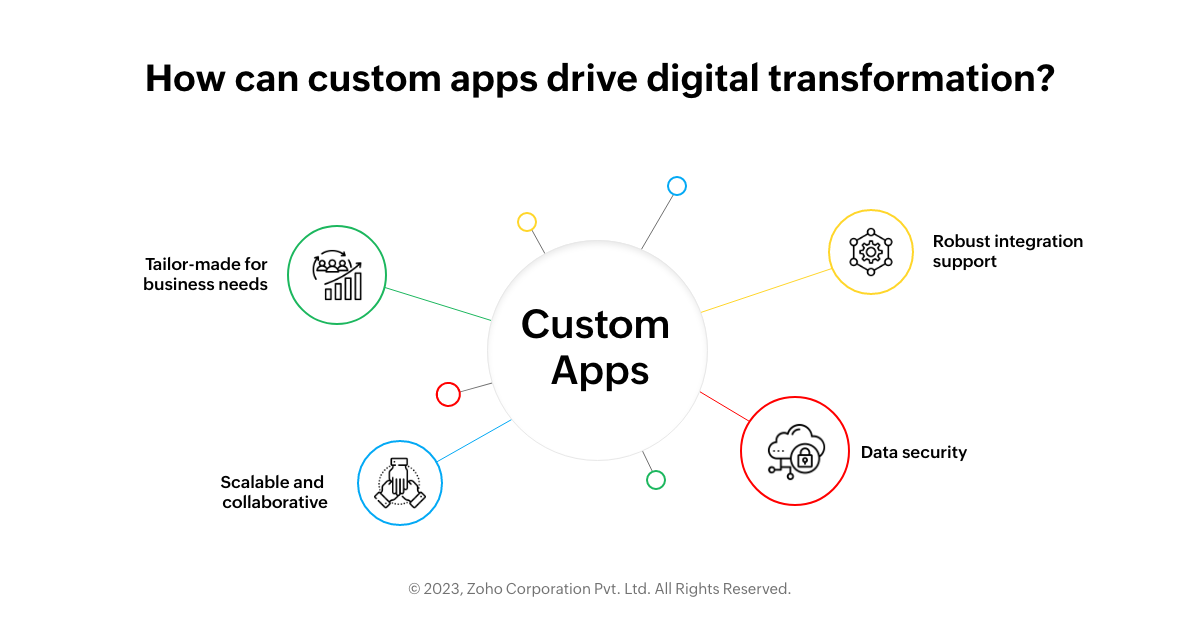- HOME
- Know Your Tech
- The role of custom apps in digital transformation
The role of custom apps in digital transformation
- Last Updated : October 25, 2023
- 2.8K Views
- 5 Min Read
A Tech Pro survey revealed that about 70% of businesses already have a digital transformation strategy in place, or are in the process of developing one. Not only does it drive business growth, but also enables businesses to stay ahead of the curve by delivering rich and immersive customer experiences.
However, kickstarting this transition is not easy.
Whether businesses hire a third-party vendor or assign digital transformation initiatives to their internal team, adopting new technologies can be time-consuming and expensive. Moreover, a lot of off-the-shelf solutions come with a steep learning curve. Hence, it's imperative for businesses to identify the best tools that can be leveraged for a swift digital technology overhaul.
How Can Your Company's Digital Transformation Be Successful?
This 21st Century has seen rapid technology growth and wide application of the Internet. These changes mean that todays businesses are unlikely to prosper in a digital world. The content that customers offer becomes increasingly difficult to differentiate. I think that this is a key step in building a truly successful digital transformation. Digital Transformation has primarily involved technologies, data, business process, and organizational change for many companies.
And one of the best approaches to usher in this digital transformation is by creating custom applications. These applications can play an important role in steering the digital transformation efforts of a business. Here's how:
How can custom apps drive digital transformation?
Custom applications are specifically designed by businesses to streamline their processes, improve overall productivity, and eventually enhance customer experience—all major objectives of the digital transformation journey.

Whether it's scaling up your infrastructure with data analytics or carrying out multiple tasks with ease, businesses can modify these applications per their strategic expectations and growth objectives. Here are a few ways in which custom apps can drive digital transformation for businesses:
Tailor-made for business needs
Every organization has its own set of requirements around the features and functionalities they need in a business-critical application. They also have certain constraints around existing technology infrastructure and available budgets. So finding an off-the-shelf solution that hits the sweet spot between requirements and constraints can be difficult.
And for small businesses, getting a full-fledged custom software development package might bring in a lot of unnecessary features and high recurring costs. On the other hand, for an enterprise, incorporating customized features and integrations on already-developed software can get complicated.
So building a custom application becomes the best way forward for businesses to have the technology solution that's aligned to their exact needs, business models and usage patterns.
Scalable and collaborative
Custom applications are developed on flexible and scalable infrastructure, to accommodate future upgrades and add-on features that may be required later. Since these applications are customized to exact business processes and needs, they can incorporate easy collaboration and seamless flow of data between multiple authorized users within the organization.
Robust integration support
A custom application can be designed to integrate with other relevant business critical applications being used across the organization. These can be third-party applications or even other in-house proprietary applications that support distinct operations. This enables easy workflow management and ensures that data and information can flow seamlessly and be leveraged as required across the organization.
Data security
For businesses, running operations on a secure platform is a priority. And security vulnerabilities are harder to monitor and respond to when the application is third-party. Custom applications give businesses visibility and control over the security safeguards put in place, and respond faster in case of security breaches.
While custom applications bring their own advantages, their development process can also become quite complex. Expecting internal IT teams to deliver them with a fast turnaround time is just not realistic. However, by choosing easier options for development, like a low-code platform, businesses can effectively overcome these obstacles.
Why leverage low-code platforms for creating custom apps
According to Gartner, by 2024, more than 65% of application development activity will be done using low-code application platforms. With user-friendly interfaces, less coding dependency, and drag-and-drop functionality, creating custom applications is a much simpler process.
Fast and cost-effective development
Creating a custom application from scratch, using traditional software development methods, can be very time consuming. And having your in-house IT teams deliver them involves significant cost and resource investments.
However, when businesses are launching an initial range of custom applications to drive digital transformation strategies, they typically want to keep costs low and evaluate ROI before ramping up investment—and low-code platforms are the best way to ensure that. Easier, faster development processes ensure quick turnaround on new applications. Businesses can launch MVPs, get feedback, and continuously improve applications without having to spend a lot of time and money on the project. With user-friendly interfaces and built-in security features in place, low-code platforms facilitate agile application development while lowering investments in the development process.
Reduced IT dependencies
Apart from managing the current tech infrastructure, creating custom apps brings an added workload for in-house developers. Moreover in many organizations, these developers are the only ones familiar with the code, so it becomes difficult for other teams to fix issues. If the project goes to inexperienced or unsuitable teams, it can lead to overshooting budgets and an underdeveloped product.
However, creating these applications on a low-code platform involves minimal dependencies on IT teams. Whether it's to fix issues or enhance the UI/UX of the application, all involved stakeholders, from product designers to business users, can leverage digital tools for visual modeling or drag-and drop-configurations for faster deployment.
Improved collaboration
Setting the right expectations and objectives at the beginning of an app development process is important. Otherwise, businesses can get stuck in the never-ending loop of making modifications to the app every now and again at different stages, since they missed on some crucial features.
However, despite the best intentions, most application development goes through a few rounds of iterations. And low-code platforms make the feedback incorporation process much easier to deal with. Because application development is happening on a platform that's visual, understandable, and accessible to designers, developers, and business users alike, it becomes easier for different groups of stakeholders to communicate and collaborate with each other. This helps the development process move faster, and ensures that the application being developed is aligned to the business needs at all points.
Developing a custom app on a low-code platform can be the right step towards achieving digital transformation goals for a business. There are definite benefits that low-code platforms offer over the traditional development process. But the most important aspect to remember is that custom applications built on low-code platforms give you the chance to start small and keep your risks low, while ensuring the possibility to scale up to a robust application once your digital business is ready for it.
 Tejas Gadhia
Tejas GadhiaTejas is an evangelist at Zoho with his focus set at enabling developers build powerful solutions using Zoho's tech stack.




